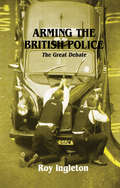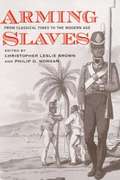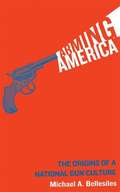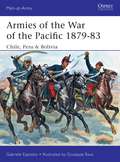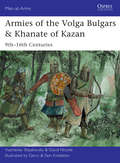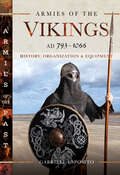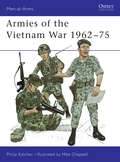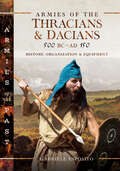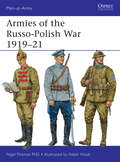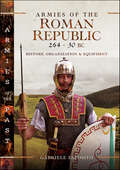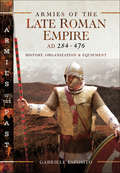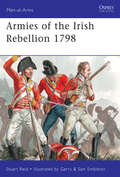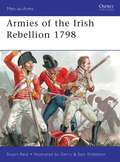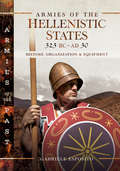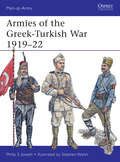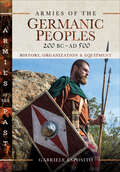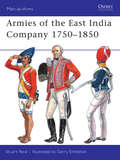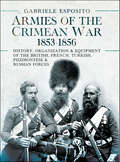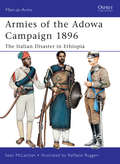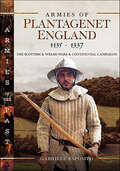- Table View
- List View
Arming the Periphery
by Emrys ChewA major historical study of the global arms trade, revolving around the transfer of small arms from metropolitan Europe to the turbulent frontiers of Indian Ocean societies during the 'long' nineteenth century (c. 1780-1914).
Arming the British Police: The Great Debate
by Roy IngletonAs the fear of violent crime escalates, there are calls for the police to carry guns. This examination of the history of violent crime and violence against the representatives of law and order looks at the extent to which the "unarmed" British police have had recourse to firearms in the past.
Arming Slaves: From Classical Times to the Modern Age
by Christopher Leslie Brown Philip D. MorganArming slaves as soldiers is a counterintuitive idea. Yet throughout history, in many varied societies, slaveholders have entrusted slaves with the use of deadly force. This book is the first to survey the practice broadly across space and time, encompassing the cultures of classical Greece, the early Islamic kingdoms of the Near East, West and East Africa, the British and French Caribbean, the United States, and Latin America. To facilitate cross-cultural comparisons, each chapter addresses four crucial issues: the social and cultural facts regarding the arming of slaves, the experience of slave soldiers, the ideological origins and consequences of equipping enslaved peoples for battle, and the impact of the practice on the status of slaves and slavery itself. What emerges from the book is a new historical understanding: the arming of slaves is neither uncommon nor paradoxical but is instead both predictable and explicable.
Arming East Russia (Adelphi series)
by Tim Huxley Susan WillettDuring the 1990s, military spending, arms procurement and defence industrialisation have all increased rapidly in East Asia. Although these developments do not constitute an arms race, they nevertheless have important implications for suppliers of defence equipment, for arms control and for regional stability. This paper assesses trends in the defence spending of East Asian states, particularly in the light of the economic crisis, which began in mid-1997. It also focuses on three closely-related issues: the nature of the regional market for defence equipment; defence industrialisation; and the effect of trends in defence procurement and industrialisation on East Asian states' military capabilities, and on the regional military balance.
Arming America: The Origins of a National Gun Culture
by Michael A. BellesilesBellesiles (history, Emory U. ) explodes a number of myths about the role of guns in American history. Examining probate records, correspondence of militia commanders, and a number of other sources he finds that gun ownership among average Americans wasn't widespread until as late as the Civil War. He also argues that from the very beginning of European settlement, guns were highly regulated by authorities and that guns were viewed as having a special status as being ultimately at the disposal of government.
Armies of the War of the Pacific 1879-83
by Gabriele EspositoThe Pacific War was the climax of the decades-long Wars of Liberation, and is one of the most important conflicts in South American history. After winning their independence from Spain in 1825, Peru and Bolivia became separate nations - but over the following years repeated attempts to re-unite them were frustrated by the neighboring powers, particularly Chile. By the 1870s Chilean military superiority and expansionist policies exploded into full scale conflict. This book examines the troops, uniforms and equipment used by forces on all three sides of the conflict and traces the events of the war from the early naval blockades to the full-scale amphibious landings undertaken by the Chilean forces. The war ended in total victory for Chile, and that country's emergence thereafter as 'the Prussia of South America', while it cost Peru a lucrative province, and Bolivia its outlet to the Pacific coast.
Armies of the Volga Bulgars & Khanate of Kazan
by Gerry Embleton Viacheslav ShpakovskyFacing off against Byzantines, Arabs, Vikings, Turks, Mongols, and Russians, this steppe culture dominated Black Sea and Caucasus trade during Medieval times.The Bulgars were a Turkic people who established a state north of the Black Sea, and who showed similarities with the Alans and Sarmatians. In the late 500s and early 600s AD their state fragmented under pressure from the Khazars; one group moved south into what became Bulgaria, but the rest moved north during the 7th and 8th centuries to the basin of the Volga river. There they remained under Khazar domination until the Khazar Khanate was defeated by Kievan (Scandinavian) Russia in 965. Thereafter the Volga Bulgars - controlling an extensive area surrounding an important hub of international trade - became richer and more influential; they embraced Islam, becoming the most northerly of medieval peoples to do so. Given their central position on trade routes, their armies were noted for the splendour of their armour and weapons, which drew upon both Western and Eastern sources and influences (as, eventually, did their fighting tactics).In the 1220s they managed to maul Genghis Khan's Mongols, who returned to devastate their towns in revenge. By the 1350s they had recovered much of their wealth, but they were caught in the middle between the Tatar Golden Horde and the Christian Russian principalities. They were ravaged by these two armies in turn on several occasions between 1360 and 1431. A new city then rose from the ashes - Kazan, originally called New Bulgar - and the successor Islamic Khanate of Kazan resisted the Russians until falling to Ivan the Terrible in 1552. The costumes, armament, armour and fighting methods of the Volga Bulgars during this momentous period are explored in this fully illustrated study.
Armies of the Vikings, AD 793–1066: History, Organization and Equipment (Armies of the Past)
by Gabriele EspositoViking warriors were feared by their contemporaries and their ferocious reputation has survived down to the present day. This book covers the military history of the Vikings from their early raiding to the final failure of their expansionist ambitions directed against England. In that period Viking warbands and increasingly large armies had left their Scandinavian homelands to range across vast regions, including the whole of Northern Europe and beyond, even reaching North America. The British Isles were terrorized for two centuries and at times largely conquered, in Normandy, Russia and elsewhere they also settled and founded states. Tough, skilled and resourceful, with a culture that embraced the pursuit of immortal fame and a heroic death in battle, their renown as warriors was second to none. As far afield as Constantinople, the Byzantine emperors employed them as their elite Varangian Guard. Gabriele Esposito outlines the history of their campaigns and battles and examines in detail their strategy, tactics, weapons, armour and clothing. The subject is brought to life by dozens of color photographs of replica equipment in use.
Armies of the Vietnam War 1962-75
by Mike Chappell Philip KatcherPhilip Katcher provides an overview to the conflict that engulfed Vietnam following the division of the country into two along the 17th Parallel in 1954. The uniforms and insignia of the US forces, including the army, Special Forces, air force, navy and marine corps, are dealt with in detail, together with those of the ARVN, the Allied Forces (such as the Royal Thai Army and Korean troops), and also the Communist NLF (Viet Cong) and NVA forces. Mike Chappell's colourful artwork provides plenty of detail to accompany this authoritative text.
Armies of the Thracians & Dacians, 500 BC–AD 150: History, Organization & Equipment (Armies of the Past)
by Gabriele EspositoContains 80 detailed photographs and illustrations of equipment used by these warring armies who dominated the ancient world.The Thracians are mentioned as early as in the epic poems by Homer and were fundamental in the evolution of the Greek military systems across the ages. They fought in the Persian Wars, were part of Alexander the Great's army, were used as mercenaries in many Hellenistic armies and resisted Roman conquest for a long time. In addition, they used some iconic weapons and had a distincitve panoply. The Dacians were a mix of different cultures and were extremely influenced by some steppe peoples like the Sarmatians. They had a lot in common with the Thracians but had a different history. They formed one of the largest and most powerful kingdoms of Antiquity, a sort of super-power that dominated over the Balkans. Their wars against Trajan and the Roman Army were absolutely epic, the last campaigns of conquest in the history of the Western Roman Empire. The book contains a rich collection of photos specifically made for it by some excellent groups of reenactors.
Armies of the Second World War: The Red Army and the Second World War
by Alexander HillIn a definitive new account of the Soviet Union at war, Alexander Hill charts the development, successes and failures of the Red Army from the industrialisation of the Soviet Union in the late 1920s through to the end of the Great Patriotic War in May 1945. Setting military strategy and operations within a broader context that includes national mobilisation on a staggering scale, the book presents a comprehensive account of the origins and course of the war from the perspective of this key Allied power. Drawing on the latest archival research and a wealth of eyewitness testimony, Hill portrays the Red Army at war from the perspective of senior leaders and men and women at the front line to reveal how the Red Army triumphed over the forces of Nazi Germany and her allies on the Eastern Front, and why it did so at such great cost.
Armies of the Russo-Polish War 1919-21
by Adam Hook Nigel ThomasFeaturing specially commissioned full-color artwork, this engaging study explains and illustrates the armies that fought in the epic struggle for the rebirth of the independent Polish nation, in the bitter aftermath of World War I and the Russian Revolution.In 1917 Poland was recognized as a state by Russia, but the Bolshevik coup threatened this. The Polish leader Marshal Pilsudski hurried to build an army around Polish World War I veterans, and in 1918 war broke out for Poland's independence, involving the the Poles, the Red and White Russian armies, at least two different Ukrainian forces, and Allied intervention troops. The armies that fought these campaigns were extraordinarily varied in their uniforms and insignia, equipment and weapons, and when peace was signed in 1921, Poland had achieved recognized nationhood for the first time since 1794.
Armies of the Roman Republic 264–30 BC: History, Organization & Equipment (Armies of the Past)
by Gabriele EspositoThe period covered in this book saw the Roman Republic face its greatest military challenges. In 264 the Romans were pitted against the might of Carthage in the first of the three Punic Wars, which would push Rome to the brink but end with the destruction of this great rival city. In the following two centuries they would clash repeatedly with the Gauls, this recurrent threat finally overcome by Caesar’s campaigns in Gaul. In this period they defeated the Hellenistic Successor states, proud heirs to the military legacy of Alexander the Great, a process completed by the annexation of Egypt in 30 BC. These wars, and others, made the Romans masters of all Western Europe and the whole Mediterranean basin, though failure against the Parthians limited their ambitions in the East. The Roman armies of this era were also employed against each other in the vicious civil wars that marked the end of the Republican period. Gabriele Esposito describes the tactics, organization, weapons and equipment of the Roman forces involved in these wars. He shows how the lessons of defeats and victories against such varied opponents in far-flung theaters, as well as social changes, forced a process of evolution and reforms that transformed Roman armies across this turbulent period. As usual, his clear, accessible text is supported by dozens of color images of replica weapons and equipment in use.
Armies of the Late Roman Empire, AD 284–476: History, Organization & Equipment (Armies Of The Past Ser.)
by Gabriele EspositoAn illustrated guide to the organization, structure, equipment, weapons, combat history, and tactics of the Late Roman military forces.This guide to the Late Roman Army focusses on the dramatic and crucial period that started with the accession of Diocletian and ended with the definitive fall of the Western Roman Empire. This was a turbulent period during which the Roman state and its armed forces changed.Gabriele Esposito challenges many stereotypes and misconceptions regarding the Late Roman Army; for example, he argues that the Roman military machine remained a reliable and efficient one until the very last decades of the Western Empire. The author describes the organization, structure, equipment, weapons, combat history and tactics of Late Roman military forces. The comitatenses (field armies), limitanei (frontier units), foederati (allied soldiers), bucellarii (mercenaries), scholae palatinae (mounted bodyguards), protectores (personal guards) and many other kinds of troops are covered.The book is lavishly illustrated in color, including the shield devices from the Notitia Dignitatum. The origins and causes for the final military fall of the Empire are discussed in detail, as well as the influence of the “barbarian” peoples on the Roman Army.Praise for Armies of the Late Roman Empire, AD 284–476“An excellent introduction to the subject for the novice, and seasoned students of the subject may find it of use as well.” —The NYMAS Review“This beautifully illustrated book depicts the very different arms and armour of the late Roman Empire as Roman soldiers adapted to the challenges of the rising barbarian armies . . . Very Highly Recommended.” —Firetrench“Superbly well-illustrated . . . historians, re-enactors and war gamers will find invaluable to understanding and picturing the Roman forces.” —Hoplite Association
Armies of the Irish Rebellion 1798
by Gerry Embleton Stuart ReidA stunning exploration of a legendary moment in Irish history. In 1798 with the British Army preoccupied in fighting France in the Caribbean and Mediterranean as well as guarding Southeast England from threatened invasion, a co-ordinated uprising broke out across the water in Ireland. Uniquely this was neither a Catholic nor a Protestant rebellion, but rather a joint effort by leaders and insurgents from both sides of the community. The Irish Rebellion (1798) was directed against the corrupt government based at Dublin Castle and was inspired in part by the people's revolutions in America and France. This title illuminates the lives of the Irish peasants, armed mostly with pikes, who confronted the small number of British troops based in their country.From the Trade Paperback edition.
Armies of the Irish Rebellion 1798
by Stuart ReidA stunning exploration of a legendary moment in Irish history. In 1798 with the British Army preoccupied in fighting France in the Caribbean and Mediterranean as well as guarding Southeast England from threatened invasion, a co-ordinated uprising broke out across the water in Ireland. Uniquely this was neither a Catholic nor a Protestant rebellion, but rather a joint effort by leaders and insurgents from both sides of the community. The Irish Rebellion (1798) was directed against the corrupt government based at Dublin Castle and was inspired in part by the people's revolutions in America and France. This title illuminates the lives of the Irish peasants, armed mostly with pikes, who confronted the small number of British troops based in their country. From the Trade Paperback edition.
Armies of the Hellenistic States, 323 BC–AD 30: History, Organization & Equipment
by Gabriele EspositoThis fully illustrated history chronicles the evolution of Hellenistic warfare from the death of Alexander the Great to Rome&’s conquest of the region. This book provides a complete and detailed analysis of the organization and equipment employed by the armies of the Hellenistic States. After Alexander the Great&’s death in 323 BC, his immense Macedonian empire was divided between his generals, who in turn formed their own monarchies across Eastern Europe, Asia and North Africa. This work will follow the development of the Hellenistic military forces from the army bequeathed by Alexander to the complex military machines that succumbed one by one in the wars against the expanding Romans. Fully illustrated with color photographs, this volume also shows how Hellenistic forces were strongly influenced by Roman models during the last years of independence of their kingdoms. The states analyzed are: Macedon, Seleucid Empire, Ptolemaic Egypt, The Greco-Bactrian Kingdom, Armenia, Pergamon, Pontus, Cappadocia, Galatia, The Bosporan Kingdom, Epirus, Sicily, The Achaean League and The Aetolian League.
Armies of the Greek-Turkish War 1919-22
by Philip JowettThis is a comprehensive guide to the armies that fought a devastating and decisive conflict in the Eastern Mediterranean between the two World Wars of the 20th century. From the initial Greek invasion, designed to "liberate" the 100,000 ethnic Greeks that lived in Western Turkey and had done for centuries, to Mustapha Kemal Ataturk's incredibly efficient formation of a national government and a regular army, this was a war that shaped the geopolitical landscape of the Mediterranean to this day. It gave birth to the modern Turkish state, displacing millions and creating bitter memories of atrocities committed by both sides. Augmented with very rare photographs and beautiful illustrations, this ground-breaking title explores the history, organization, and appearance of the armies, both guerilla and conventional, that fought in this bloody war.
Armies of the Germanic Peoples, 200 BC–AD 500: History, Organization & Equipment
by Gabriele EspositoGabriele Esposito presents an overview of the military history of the Germanic peoples of this period and describes in detail the weapons and tactics they employed on the battlefield. He starts by showing how, from very early on, the Germanic communities were heavily influenced by Celtic culture. He then moves on to describe the major military events, starting with the first major encounter between the Germanic tribes and the Romans: the invasion by the Cimbri and Teutones. Julius Caesar's campaigns against German groups seeking to enter Gaul are described in detail as is the pivotal Battle of the Teutoburg Forest, which effectively halted Roman expansion into Germany and for centuries fixed the Rhine as the border between the Roman and Germanic civilizations. Escalating pressure of Germanic raids and invasions was a major factor in the collapse of the Western Roman Empire. The author's analysis explains how Germanic warriors were able to crush the Roman military forces on several occasions, gradually transformed the Roman Army itself from the inside and, after the fall of the Empire, created new Romano-Germanic Kingdoms across Europe. The evolution of Germanic weapons, equipment and tactics is examined and brought to life through dozens of color photos of replica equipment in use.
Armies of the East India Company 1750-1850
by Gerry Embleton Stuart ReidContrary to popular belief, the capture of India was not accomplished by the British Army, but by the private armies of the East India Company, whose primary objective was the protection of their trading empire. Under the leadership of the legendary Robert Clive (founder of the East India Company) and Stringer Lawrence, this small force of mercenaries and adventurers grew in size and strength to eventually become an army larger than that of any European sovereign state. Highly disciplined and professional, it fought almost continuously for a century until the Great Mutiny of 1857 led to its disbandment and its troops passed into Crown service. One of the many British Army officers who fought with this force was Arthur Wellesley, the future Duke of Wellington. This is the fascinating history of the East India Company army, examining the many conflicts in which they fought, and their equipment and training, with its regiments of horse, foot and guns, which rivalled those of most European powers. The exotic uniforms combining traditional Indian and British dress are illustrated in detail and make for a wonderfully colorful account of a private band of adventurers that successfully captured the jewel of the British Empire.
Armies of the Crimean War, 1853–1856: History, Organization and Equipment of the British, French, Turkish, Piedmontese and Russian forces
by Gabriele EspositoLavishly illustrated with over 100 illustrations that detail the composition, organization, uniforms, weapons and equipment of each force. The Crimean War was the first major European war since the end of the Napoleonic Wars and Britain’s only war on that continent in the century between Waterloo and WW1. When Russia invaded provinces of the Ottoman Empire, the British and French, later joined by the Kingdom of Piedmont-Sardinia, intervened to limit Russian expansion towards the Black Sea. Each of the armies contained an eclectic mix of units. The regular European regiments still displayed much of the bright color and finery associated with the Napoleonic era (the British infantry in their scarlet tunics forming the famous ‘thin red line’ at Balaklava for instance), while each also contained a mix of exotic units drawn from across their respective empires. The French fielded Zouaves and Spahis from North and West Africa, not to mention the legendary Foreign Legion; the Ottomans had Tunisians and Egyptians alongside Balkan mountaineers and the infamous Bashi-bazouks; the Russians of course had their Cossacks and the British fielded little-known German, Swiss and Italian mercenaries. Gabriele Esposito details the composition, organization, uniforms and weaponry of each force and illustrates many of them with early black and white photos (this being the first major war for which photography was available), as well as numerous color artworks.
Armies of the Balkan Wars 1912-13: The Priming Charge for the Great War
by Philip S. JowettIn 1912, the Balkan states formed an alliance in an effort to break free from the crumbling Ottoman Empire. Forming an army of some 645,000 troops from Greece, Bulgaria, Serbia and Montenego, they took on a force of 400,000 Turkish soldiers. Both sides were equipped with the latest weapons technology. This book looks at the diverse and sometimes colorful uniforms worn by both sides, paying special attention to insignia, weapons and equipment. It also gives an overview of the campaign that became a "priming pan" of World War I.
Armies of the Adowa Campaign 1896
by Sean Mclachlan Raffaele RuggeriIn the late 19th century, the new nation-state of Italy was eager to join her European neighbors in creating an international empire. Italy's eyes turned towards Africa as a source of potential colonies. Most of the continent had already been carved up between the Great Powers but Italy succeeded in securing a foothold in Eritrea on the Red Sea coast, a vassal of the Emperor of Ethiopia. Trade and other links were established with the Ethiopian empire but quarrels regarding the interpretation of a particular clause led to Ethiopian support for uprisings in Eritrea. Italian troops entered northern Ethiopia and captured Adowa, the capital of the Tigray province. Full-scale war broke out and this new Osprey title tracks every development in the battle and the men who fought in it.From the Trade Paperback edition.
Armies of Plantagenet England, 1135–1337: The Scottish & Welsh Wars & Continental Campaigns (Armies Of The Past Ser.)
by Gabriele EspositoThe ascent of the Plantagenets to the English throne in 1154 led to the beginning of a new historical phase in the British Isles, which was marked by numerous wars that were fought between the Kingdom of England and the 'Celtic nations' of Wales, Scotland and Ireland. During the rule of the Norman kings, the English armies had not completed the conquest of Wales and had established only some footholds in Ireland; Scotland was still independent and was ready to contest the Plantagenets’ possession of northern England. As a result of this situation, the two centuries between the rise of the new dynasty and the beginning of the Hundred Years’ War were characterized by a series of wars that ravaged feudal England. Gabriele Esposito covers all these conflicts, following the campaigns of Richard the Lionheart as well as those of his younger brother who was defeated on the continent at the large Battle of Bouvines; the conquest of Wales is analyzed in detail, as well as the First Scottish War of Independence that saw William Wallace playing a prominent role. The organization and equipment of all the troop types taken into account is described in full detail and lavishly illustrated with color images of reenactors, bringing these forces to life.
Armies of Empire
by Allan ConverseThe study of military history forms a critical part of the Army's learning cycle. By publishing the work of the nation's pre-eminent military historians, the Australian Army and Cambridge University Press aim to promote, to a worldwide audience, our country's proud military heritage. Detailing the history of the Army, its people and its contribution to Australia's development, the series presents readers with contemporary perspectives and authoritative accounts of the key issues in the Army's past. The Australian Army is pleased to collaborate with Cambridge University Press to deliver the official Australian Army History Series. Book jacket.

